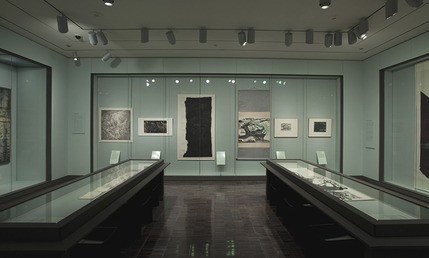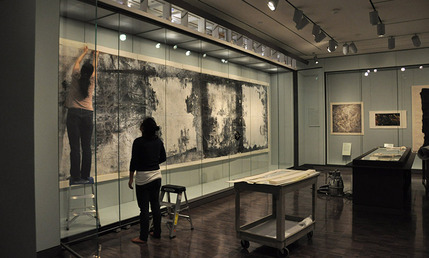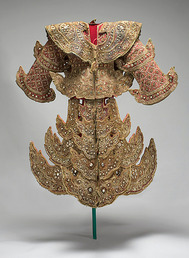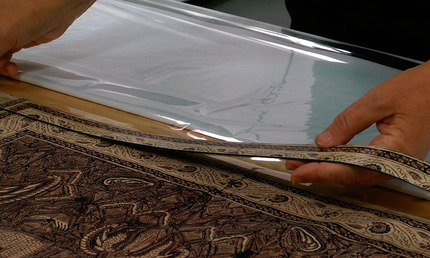Preventive conservation can cover a wide range of activities and subjects, from maintaining the proper temperature and humidity in art storage to something as simple as wearing gloves when handling art. With this in mind, the Conservation Department has begun hanging art in a new way—with magnets!
A good display mount is a critical factor in protecting delicate art. Artwork often needs to be displayed on gallery walls without a traditional frame, for a number of reasons. Asian paintings were seldom designed for European-style frames, while many costumes are simply too bulky. Displaying such works has traditionally required hidden pins, stitching, or paper hinges, but a new generation of super-strong rare earth magnets offers a new option. These reusable magnets serve as gentle clamps, pressing the artwork against a padded sheet of steel hidden inside a backing board. The pressure can be adjusted by adding more magnets or padding, and the artwork need not be altered by pins, sewing, or other attachments. These reusable mounts can be quickly installed, saving time and money.


Fragile, heavy costumes often need internal padding to support their weight and give them shape. Three-dimensional figures, hanging rods, and customized inserts can help to show how clothing might have looked on a living person or displayed in a home.



The multi-part costume is assembled on the mount using a combination of pins, stitching and magnetic buttons. Magnetic buttons hidden in the decoration give the heavy costume additional support. To disguise the magnets, inexpensive costume gems are toned with acrylic paint and attached to the magnets with double-stick tape.

Each mount is designed with a very specific display in mind. In the exhibition Batik: Spectacular Textiles of Java, curator Natasha Reichle wanted to show visitors how the textiles might be worn or stored in the home, so designer Marco Centin and textile conservator Denise Migdail created dynamic mounts in hanging and draped styles. A conservator always prefers to use the least invasive method to mount an art object for display, so Migdail took advantage of the flat, lightweight nature of batiks to use thin, bendable ‘refrigerator’ magnets for support instead of pins.

Beneath their elegant fabrics, the panels lining the gallery cases are complex constructions of aluminum composite and galvanized steel.

Magnetic mount systems are constructed in two parts. First, rare-earth magnets are embedded into strips of archival museum board and cut into strips. The strips are customized for strength, size, shape and color to match the needs of each artwork.

Next, a display panel is fabricated to support the artwork and attract the magnets. Hangers are attached to the back of the display panel, and steel sheeting adhered to the front. The mount edges are smoothed and sealed.

Next, the mount is covered with a protective flannel layer, followed by a finish fabric that matches the gallery design. All the materials, including the fabrics, are tested for archival stability to protect the art from chemicals or bleeding dyes.

Stephen Heer, “The Sacrifice by James Nactwey: Gallery Installation of a 32 ft. 3.-long Photograph with Flexible Magnets” AIC: Connecting to Conservation: Outreach and Advocacy Abstract Book 2012 98-99.
Daria Keynan, Julie Barten and Elizabeth Estabrook, “Installation methods for Robert Ryman’s wall-mounted works, The Paper Conservator Volume 31 (2007): 7-15.
Gwen Spicer, http://www.spicerart.com/page90/page90.html.
Gwen Spicer, “Defying Gravity with Magnetism” AICNews (Nov. 2010) vol. 35, 6:1,3-5.
Gwen Spicer, “Ferrous Attraction and The Science Behind the Magic” http://insidetheconservatorsstudio.blogspot.com/2013/05/ferrous-attraction-and-science-behind.html (2013).
American Institute for Conservation Object Specialty Group Wiki, Magnet Mounts, (2011-12).